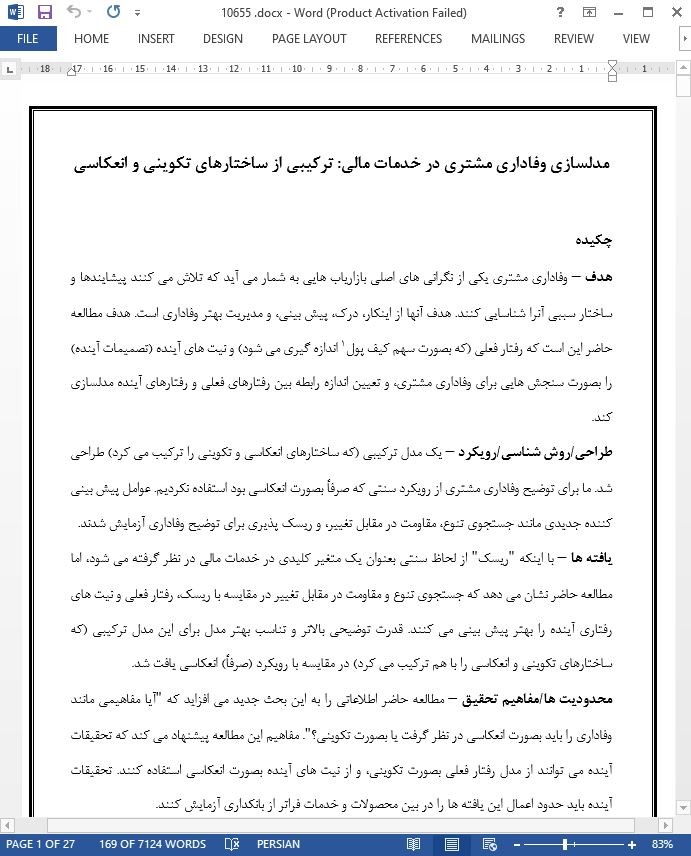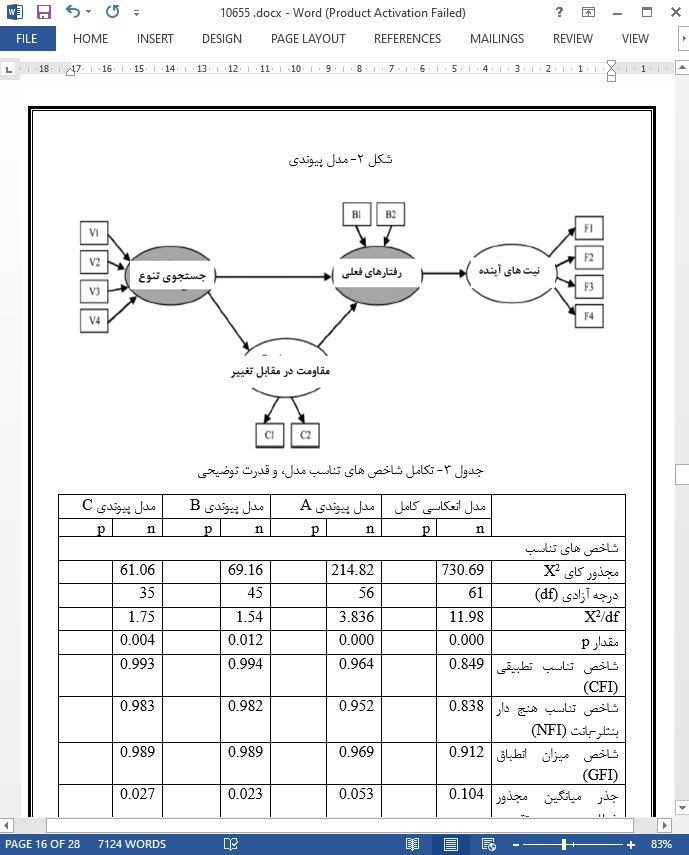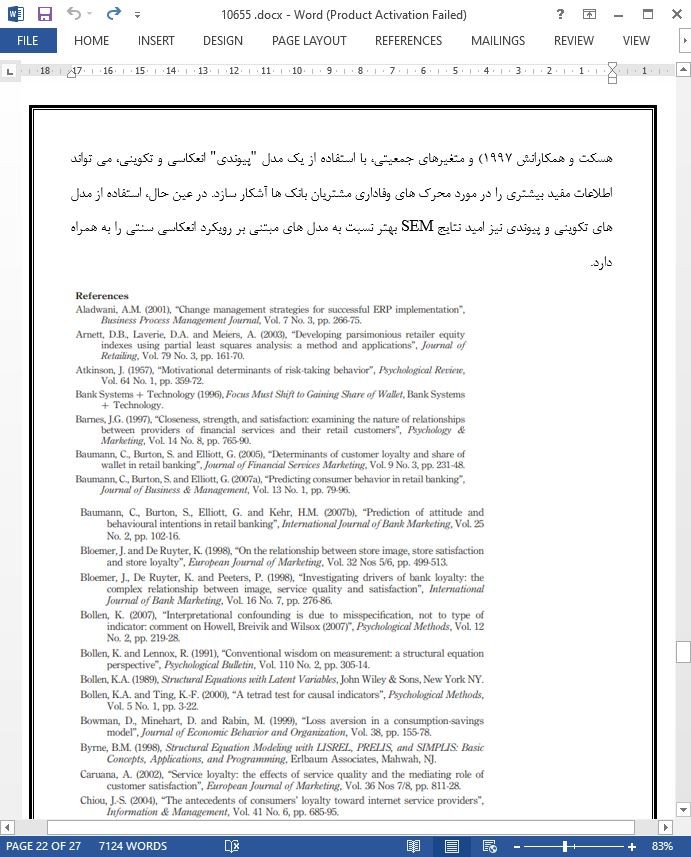
مدلسازی وفاداری مشتری در خدمات مالی: ترکیبی از ساختارهای تکوینی و انعکاسی
چکیده
هدف – وفاداری مشتری یکی از نگرانی های اصلی بازاریاب هایی به شمار می آید که تلاش می کنند پیشایندها و ساختار سببی آنرا شناسایی کنند. هدف آنها از اینکار، درک، پیش بینی، و مدیریت بهتر وفاداری است. هدف مطالعه حاضر این است که رفتار فعلی (که بصورت سهم کیف پول اندازه گیری می شود) و نیت های آینده (تصمیمات آینده) را بصورت سنجش هایی برای وفاداری مشتری، و تعیین اندازه رابطه بین رفتارهای فعلی و رفتارهای آینده مدلسازی کند.
طراحی/روش شناسی/رویکرد – یک مدل ترکیبی (که ساختارهای انعکاسی و تکوینی را ترکیب می کرد) طراحی شد. ما برای توضیح وفاداری مشتری از رویکرد سنتی که صرفاً بصورت انعکاسی بود استفاده نکردیم. عوامل پیش بینی کننده جدیدی مانند جستجوی تنوع، مقاومت در مقابل تغییر، و ریسک پذیری برای توضیح وفاداری آزمایش شدند.
یافته ها – با اینکه "ریسک" از لحاظ سنتی بعنوان یک متغیر کلیدی در خدمات مالی در نظر گرفته می شود، اما مطالعه حاضر نشان می دهد که جستجوی تنوع و مقاومت در مقابل تغییر در مقایسه با ریسک، رفتار فعلی و نیت های رفتاری آینده را بهتر پیش بینی می کنند. قدرت توضیحی بالاتر و تناسب بهتر مدل برای این مدل ترکیبی (که ساختارهای تکوینی و انعکاسی را با هم ترکیب می کرد) در مقایسه با رویکرد (صرفاً) انعکاسی یافت شد.
محدودیت ها/مفاهیم تحقیق – مطالعه حاضر اطلاعاتی را به این بحث جدید می افزاید که "آیا مفاهیمی مانند وفاداری را باید بصورت انعکاسی در نظر گرفت یا بصورت تکوینی؟". مفاهیم این مطالعه پیشنهاد می کند که تحقیقات آینده می توانند از مدل رفتار فعلی بصورت تکوینی، و از نیت های آینده بصورت انعکاسی استفاده کنند. تحقیقات آینده باید حدود اعمال این یافته ها را در بین محصولات و خدمات فراتر از بانکداری آزمایش کنند.
ابتکار/ارزش – مطالعه حاضر نشان میدهد که جستجوی تنوع و مقاومت در مقابل تغییر می توانند وفاداری را بخوبی توضیح دهند و آنرا پیش بینی کنند. آزمایش مفاهیم تکوینی و انعکای در توضیح وفاداری نیز یک پدیده جدید است.
مقدمه
موضوع وفاداری مشتری از نگرانی مهم بازاریاب هایی به شمار می آید که تلاش می کنند پیشایندها و ساختار سببی آنرا شناسایی کنند. هدف آنها از اینکار، درک، پیش بینی و مدیریت بهتر وفاداری است. تحقیقات قبلی مربوط به وفاداری تا حد زیادی بر این الگوی فکری متمرکز بوده اند که "رضایت منجر به وفاداری می گردد" (بعنوان مثال هالووِل 1996؛ لی و همکارانش 2001). این تحقیقات تا حد زیادی وفاداری را بصورت نیت های آینده یا بصورت شکلی از رفتار فعلی یا رفتار گذشته مدلسازی کرده اند (اِوینگ 2000؛ جانسون و همکارانش 2006). البته این مطالعه از رویکرد رضایت-وفاداری دور می شود چون مشخص شده است که این رابطه در محتوای خدمات مالی، نسبتاً ضعیف است (بارنِس 1997؛ کریشنان و همکارانش 1999). ما در عوض، سه عامل پیش بینی کننده را برای توضیح وفاداری آزمایش کرده ایم:
(1) جستجوی تنوع
(2) مقاومت در مقابل تغییر
(3) ریسک پذیری
بحث و نتیجه گیری
اهداف مطالعه حاضر این بود که مفهوم وفاداری مشتری و پیشایندهای سببی آنرا با استفاده از هر دو سنجش تکوینی و انعکاسی در SEM بررسی کنیم. این مطالعه سبب غنی تر شدن مقالات مربوط به وفاداری مشتری می شود چون پیش بین های جدیدی را تست کرده است: جستجوی تنوع، مقاومت در مقابل تغییر، و رفتار ریسک پذیری (جزئیات برآوردها و مقادیر p در جدول 3 نشان داده شده است). جستجوی تنوع رابطه مهمی با رفتارهای فعلی دارد، و توسط سهم کیف پول ، از طریق مقاومت در مقابل تغییر سنجیده می شود، و رفتارهای فعلی نیز رابطه مهمی با نیت های آینده داشتند (که بر اساس نیت های تصمیم گیری برای "مشتری باقی ماندن" سنجیده شد). قدرت توضیحی بالایی در این مطالعه در توضیح و پیش بینی وفاداری یافت شد. "R به توان دوهای تعدیل شده" نشان می دهند که 99.7 درصد رفتارهای فعلی، و 50 درصد نیت های آینده را می توان توضیح داد (به مدل پیوندی C نگاه کنید).
Abstract
Purpose Customer loyalty is a focal concern for marketers who seek to identify its antecedents and causal structure with the aim of better understanding, predicting and managing loyalty. The purpose of this paper is to model both current behaviour (measured as share of wallet) and future intentions as measures of customer loyalty, to quantify the link between current and future behaviour.
Design/methodology/approach A hybrid model, combining reflective and formative constructs, was developed, moving away from the traditional “reflective only” approach to explain customer loyalty. New predictors such as variety seeking, “resistance to change” and risk taking behaviour were tested to explain loyalty.
Findings While “risk” is traditionally viewed as a key variable in financial services, this study finds that variety seeking and “resistance to change” predicted current behaviour and future behavioural intentions better than risk. Higher explanatory power and better model fit was found for a hybrid model combining formative and reflective constructs; in contrast to the more common fully reflective approach.
Research limitations/implications This study adds to the emerging debate on whether concepts such as loyalty should be treated as reflective and/or formative. The implications from this study suggest that future research can usefully model current behaviour as formative and future intentions as reflective. Future research should test the extent that these findings apply across products and services beyond banking.
Originality/value This study establishes that variety seeking and “resistance to change” can usefully explain and predict loyalty. The examination of “formative” and “reflective” concepts in explaining loyalty is also novel.
Introduction
The topic of customer loyalty is a focal concern for marketers who seek to identify its antecedents and causal structure with the aim of better understanding, predicting and managing loyalty. Previous loyalty research has heavily focused on the “satisfaction leads to loyalty” paradigm (e.g. Hallowell, 1996; Lee et al., 2001), and has largely modelled loyalty as either future intentions or some form of current or past behaviour (Ewing, 2000; Johnson et al., 2006). This study, however, moves away from the satisfaction-loyalty approach since the association has been shown to be relatively weak in the financial services context (Barnes, 1997; Krishnan et al., 1999), and instead tests three new predictors to explain loyalty: (1) variety seeking; (2) resistance to change; and (3) risk taking.
Discussion and conclusion
The objectives of this study were to explore the concept of customer loyalty and its causal antecedents using both formative and reflective measurements in SEM. This study adds to the customer loyalty literature since new predictors have been tested: namely, variety seeking, resistance to change and risk taking behaviour (details of the estimates and p values are shown in Table III). Variety seeking is significantly associated with current behaviour, measured as share of wallet, via resistance to change, and current behaviour was significantly associated with future intentions (as measured in intentions to remain a customer). High explanatory power was found in this study in explaining, and thus predicting, loyalty. Adjusted R-squares suggest that 99.7 per cent of current behaviour, and 50 per cent of future intentions can be explained (see hybrid model C).
چکیده
مقدمه
پیشایندهای وفاداری مشتری
ساختار و سنجش وفاداری در خدمات مالی
مدلسازی وفاداری با استفاده از مدلسازی معادله ساختاری
ملاحظات تئوری و تجربی در شناسایی ساختارهای SEM
مطالعه حاضر
آزمایش مدل های انعکاسی و تکوینی وفاداری مشتری
توسعه اقتصادی ترین مدل پیوندی
بحث و نتیجه گیری
Abstract
Introduction
Antecedents of customer loyalty
Construct and measurement of loyalty in financial services
Modelling loyalty using structural equation modelling
Theoretical and empirical considerations in identifying SEM constructs
The current study
Testing reflective and formative models of customer loyalty
Development of the most parsimonious hybrid model
Discussion and conclusion
- اصل مقاله انگلیسی با فرمت ورد (word) با قابلیت ویرایش
- ترجمه فارسی مقاله با فرمت ورد (word) با قابلیت ویرایش، بدون آرم سایت ای ترجمه
- ترجمه فارسی مقاله با فرمت pdf، بدون آرم سایت ای ترجمه



